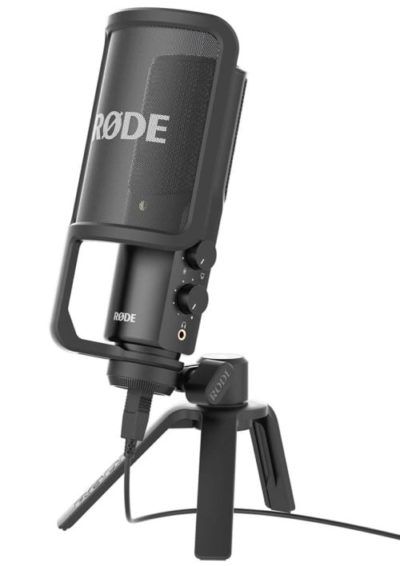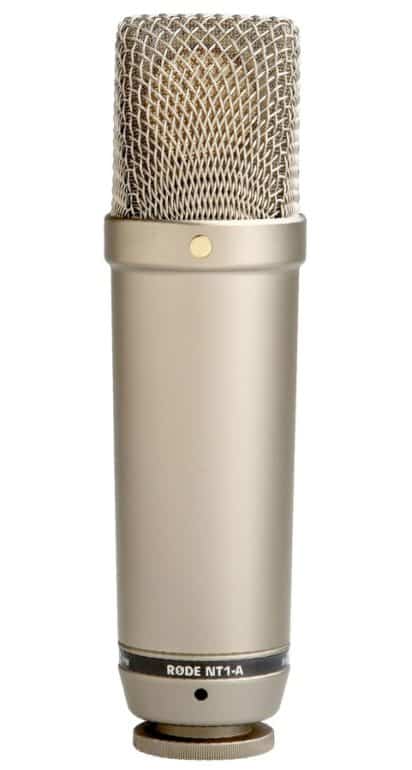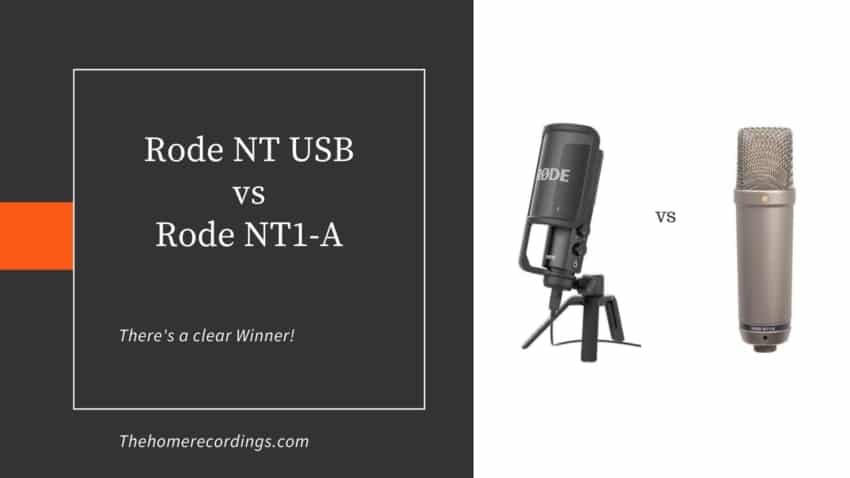Last updated on December 30th, 2023 at 02:58 pm
In this article I will be comparing the Rode NT USB and the Rode NT1a, and I will give you my honest opinion on which microphone you should choose… Spoiler alert, there’s a clear winner.
Let’s get started with the basic differences between the two…
Rode NT USB vs Rode NT1-a
The main difference between these two microphones is that the Rode NT connects to the computer via USB, while the Rode NT1a has an XLR connector on the bottom.
XLR connections are more versatile because they let you connect the microphone to more devices and not just a computer, such as Audio Interfaces, Mixers, Portable Recorders, etc.
In short, USB microphones are more “beginner friendly” than XLR ones for the simple fact that they are plug n’ play devices and that no additional equipment is required to use them.
In this particular case, the Rode NT1a is a vastly superior microphone overall, in fact, I use it in my home studio almost every day.
The only issue is that you would need to invest in an Audio Interface, and this will definitely be more expensive than getting the USB microphone, but it’s a much better setup in every way you look at it.
I wrote a post comparing USB microphones to XLR ones, their pros and cons, and much more, that you should definitely give a quick read before you decide what to do.
Now, let’s get into the microphones themselves.
Rode NT USB

The Rode NT USB is a pretty good Condenser USB cardioid microphone… Emphasis on “Pretty Good”.
Rode is known for making extremely high-quality equipment at reasonable prices, and the Rode NT USB is no exception to this rule, except for one thing, which I’ll mention in a second.
It comes with a pop filter, a tripod desk stand, a ring mount, a USB cable, and a storage pouch.
The two controls on the side are for the headphone volume, which comes in handy when you want to do zero latency monitoring, and the Direct mix control between mic input and source output.
This means that you can choose to hear only what’s coming out of the PC, to only hear the direct signal from the Mic, or a blend of those.
Now, you might have noticed that it doesn’t come with a Gain dial, which for a mic in this price-range is just ludicrous.
In all honesty, I don’t like this at all…
You can control the levels from your PC however, but this isn’t ideal since it simply takes too much time.
This microphone is good for recording singing, as well as spoken word; such as podcasting and voice-over, YouTube videos, etc.
When looking at the build quality I have to say that it’s excellent; the microphone itself is super heavy and completely made of metal, and the knobs on the side don’t wiggle one bit.
Like I mentioned, it includes a pop filter, which is rare since most microphones don’t include one, but this pop filter is made of plastic, so be careful with it.
As far as the pickup pattern goes, it’s a Cardioid microphone, meaning that it only picks up sound coming from the front while rejecting anything hitting it from the sides or rear.
Lastly, it works on Windows and Mac OS based computers, as well as the Apple iPad, and all you have to do is plug it in and that’s it.
How does it perform?
To be honest, I wasn’t as surprised as I thought I would be when trying out this mic.
For spoken word applications or for quiet singing it works super well, however when recording instruments that are a bit too loud, or any other loud sound source for that matter, even if the signal doesn’t clip it will sound as if it’s clipping.
Note: Clipping is that distortion sound you hear when the signal is too loud.
Also, having no Gain dial makes it a bit of a pain to set the levels correctly.
Other than that, I think that the Rode NT USB does a pretty decent job at doing what it’s supposed to do, just remember to not record very hot signals.
What comes in the box?
- The Rode NT USB Microphone
- Pop Filter
- Microphone Stand
- Microphone Mount
- Storage Pouch
Features
- Polar Pattern: Cardioid
- Pop shield, Tripod desk stand, ring mount, storage pouch and 6m (20’) USB cable included
- Includes Headphone Jack
- Frequency Response: 20Hz -20KHz
- Sample Rate: 48KHz/16-bit
Specifications
- Polar Pattern; Cardioid
- Frequency Response: 20Hz- 20kHz
- Sample Rate: 48kHz/16-bit
- Max SPL: 110dB
- Weight: 520g
Find out more about the Rode NT USB here.
- Rode NT USB: Amazon, Sweetwater.
Rode NT1a

The Rode NT1a is one of the most famous and used microphones in the recording industry.
Some people praise it as if it were the best microphone to be ever created and they even compare it to other ones that are in a much higher price range.
The reason why the Rode NT1a is so good is because it will give you a very accurate representation of what is being recorded, meaning that it should easily fit within any mix.
It has a very natural sound, even though after reading some reviews online I found that people complained about it having a bit of a harshness, or high frequency/presence boost, which is actually quite common on microphones at this price range.
However, this all depends on your specific taste, since every microphone will have its own character.
Some people might find that it enhances their voice, while others may find that it makes their voice sound horrible and shrill.
What I’ve found over the years is that having that boost just gives the sound -especially vocals- a pre-produced sound and the tracks usually need a bit less EQing to fit in the fix.
Now, as far as the build quality goes, I honestly can’t complain at all!
It’s absolutely fantastic and it’s built to last.
Sadly, the Rode NT1a doesn’t come with a PAD or High–Pass filter, it’s just the bare microphone, but it is a great performer and it does what it’s supposed to do.
It has a slight boost at around 150Hz and at the 6k to 12kHz range, with a deep cut at the high-end; all this means that it will be actually quite bright sounding, which is what I referred to earlier by saying that people found it to be a bit harsh at times.
How does it Perform?
I found it great for recording vocals, acoustic guitar and electric guitar, but to be honest… once you get to this level of microphone it gets hard to really find one that doesn’t sound great.
It all comes down to your own preferences, what kind of tone you’re going for, etc.
I actually do like the high-end boost a bit since it gives it a more “airy” sound, plus it helps the tracks to better fit in the fix, like I mentioned.
This is also something that works well with acoustic guitars, since that high-end boost really opens up the higher frequencies, making the guitar sound better.
As I mentioned earlier, it all depends on your personal taste.
If you want a microphone that has an identical build quality but sounds a bit darker, then check out the Rode NT1.
You can find that one in my post about the best microphones under $300.
Pros
- The build quality is fantastic.
- The shock mount is metal, when most included ones are made of plastic.
- It’s insanely quiet (Low self-noise).
- Open and Airy high-end.
- Can Handle high SPL.
Cons
- The presence boost could make your recordings too bright. It can also you make your vocals a bit more sibilant.
- The included cable isn’t the best one.
What comes in the Box?
- The Rode NT1a microphone.
- A Storage Pouch.
- You also get the shock mount which comes with a pop filter already attached.
- XLR cable.
Specifications
- Polar Pattern: Cardioid
- Frequency Response: 20Hz – 20kHz
- SPL: max 137dB
- Impedance: 100 Ohms
- Sensitivity: -32dB
- Self Noise: 5dB
Find out more about the Rode NT1a here:
- Rode NT1a: Amazon, Sweetwater.
Which one should you Choose?
USB microphones are simple to use, but if you ever want to upgrade you will need to ditch the microphone entirely and get new equipment.
This is why I’m always in favor of purchasing an Audio Interface and an XLR microphone/s.
In this particular case, the Rode NT1a has the Rode NT USB beat by a mile; I would never recommend the Rode NT USB to anyone over the NT1a since there’s a huge difference in sound quality between the two.
If you’re certain that you need a USB microphone and that upgrading later on won’t be necessary, then I’d advise you to look into either the Samson G-Track Pro or the Blue Yeti.
Lastly, if you are someone who is looking to make music from home, run a podcast with guests, or anything similar, then definitely get an Audio Interface with more than one Input and purchase separate XLR mics.
Note: XLR connections will also yield a better audio quality since they are designed to reduce noise.
Conclusion
It’s hard to beat the Rode NT1a, I mean they use it in high-end studios all the time.
The Rode NT USB on the other hand, doesn’t have a Gain Control, which doesn’t make any sense, plus if you ever want to be able to record multiple sources, you would end up having to purchase an Audio Interface with XLR microphones anyway.
So, in my opinion, go with the Rode NT1a, no questions asked.
I hope this was useful!
Have a nice day!

Helpful review. Ordering it up. I don’t do music, only audio podcasting and voice-over for videos, maybe use it in video calls. USB interface is huge convenience, price is attractive, imperfections can be dealt with in post production software for voiceovers. Lots of other reviews less critical but trustworthy.
Definitely useful, thanks!
Solid review – job well done!
Thank you! This was very useful and to the point! I had just bought NT1-A for vocals and was wondering how well would it perform in a podcasting situation. You helped me settle with my purchase!